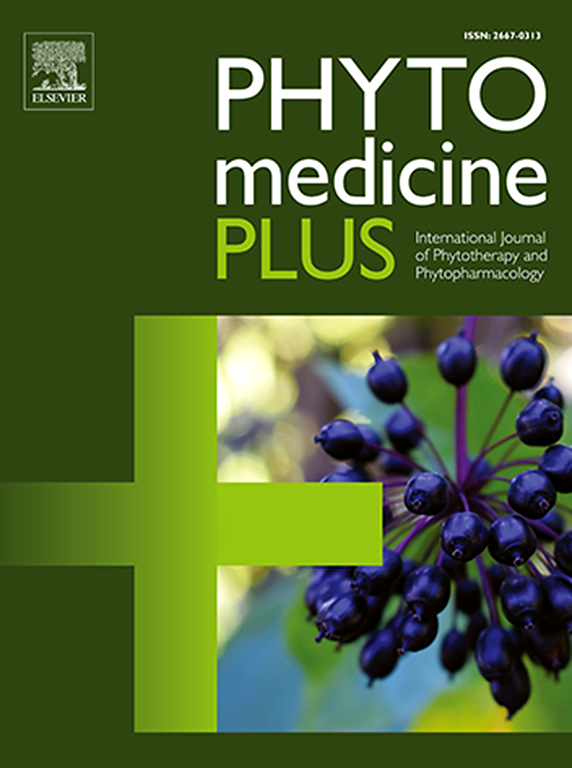Chronic excess ethanol exacerbates post-ischaemic vascular dementia in rats: the potential of Ficus platyphylla Delile to reverse motor and behavioral sequelae
Q3 Pharmacology, Toxicology and Pharmaceutics
引用次数: 0
Abstract
Ethnopharmacological Relevance
Ficus platyphylla Delile (Moraceae) is traditionally used in Africa to treat cognitive disorders, epilepsy, and psychosis.
Aim of the Study
To evaluate the effect of Ficus platyphylla (FP) trunk bark aqueous extract on ischaemic stroke-induced vascular dementia, exacerbated by chronic and excessive ethanol exposure in adult rats.
Materials and Methods
Fifty-eight male rats were divided into nine groups: Normal group received distilled water (DW) at 10 mL/kg (n=4), SHAM group received ethanol (EtOH) 35% at 5 mL/kg (n=10), Negative group 1 underwent the CIS procedure (n=4), Negative group 2 underwent the CIS procedure and received EtOH (n=10), positive group 1 received Aspirin at 30 mg/kg (n=6), Positive group 2 received Piracetam at 200 mg/kg (n=6) and Experimental groups (3 groups) treated with FP aqueous extract at doses of 100, 200, and 300 mg/kg (n=6 each). Rats were pretreated with ethanol for 30 days, followed by the CIS procedure. Four rats from the first four groups were randomly selected and sacrificed to validate the model. The remaining rats underwent 14 days of treatment with FP extract or reference substances. Memory impairment was evaluated using the Y-maze test (YMT) and novel object recognition test (NORT). Motor activity was assessed through the grid suspension test (GST) and Raised Beam Test (RBT). Oxidative and nitrosative stress markers, pro-inflammatory cytokine levels, and acetylcholinesterase (AchE) activity were measured in brain homogenates after euthanasia. Histological analysis of the hippocampus and cortex was conducted. Acute and sub-acute toxicological studies of FP extract were carried out in accordance with OECD guidelines (425 for acute toxicity and 407 for sub-acute toxicity).
Results
Model validation showed that combined EtOH and CIS increased neurological scores (p < 0.01), IL-1β levels (p < 0.05), NO levels (p < 0.01), and MDA levels (p < 0.001), while reducing SOD (p < 0.001) and GPx activity (p < 0.05) compared to rats subjected only to the CIS procedure. Treatment with FP aqueous extract (100, 200, and 300 mg/kg) improved (p < 0.001) spontaneous alternation in the YMT and discrimination index in the NORT, compared to the EtOH + CIS group. At 200 and 300 mg/kg, FP extract significantly (p < 0.001) increased grip time in the GST and reduced latency time (p < 0.01) in the RBT, reduced (p < 0.01) AchE activity, MDA concentration, and NO levels, while enhancing SOD and GPx activity, compared to the EtOH + CIS group. The extract also decreased (p < 0.001) IL-1β, TNF-α, and IL-6 levels across all doses, compared to the EtOH + CIS group. No signs of toxicity were observed at therapeutic doses of FP extract.
Conclusion
The aqueous extract of Ficus platyphylla trunk bark (100, 200, and 300 mg/kg) reversed memory impairment and motor deficits induced by cerebral ischaemic surgery and exacerbated by chronic excessive ethanol consumption, with the 200mg dose as the most active dose. These neuroprotective effects may be attributed to the extract’s anticholinesterase, antioxidant, and anti-inflammatory properties.

慢性过量乙醇加重大鼠缺血后血管性痴呆:白叶榕逆转运动和行为后遗症的潜力
民族药理学意义非洲传统上使用白桦治疗认知障碍、癫痫和精神病。研究目的评价白叶榕(Ficus platyphylla, FP)树干树皮水提物对成年大鼠慢性过量乙醇暴露加重的缺血性脑卒中血管性痴呆的作用。材料与方法雄性大鼠58只,分为9组:正常组接受10 mL/kg蒸馏水(DW)治疗(n=4), SHAM组接受5 mL/kg 35%乙醇(EtOH)治疗(n=10),阴性组1接受CIS治疗(n=4),阴性组2接受CIS治疗并接受EtOH治疗(n=10),阳性组1接受30 mg/kg阿司匹林治疗(n=6),阳性组2接受200 mg/kg吡拉西坦治疗(n=6),实验组(3组)分别接受100、200、300 mg/kg剂量的FP水提物治疗(n=6)。用乙醇预处理大鼠30天,然后进行CIS程序。前4组随机选取4只大鼠处死,验证模型。其余大鼠分别用FP提取物或对照物治疗14天。采用y迷宫测试(YMT)和新物体识别测试(NORT)评估记忆障碍。通过网格悬浮试验(GST)和凸起梁试验(RBT)评估运动活动。在安乐死后的脑匀浆中测量氧化和亚硝化应激标志物、促炎细胞因子水平和乙酰胆碱酯酶(AchE)活性。对海马和皮质进行组织学分析。FP提取物的急性和亚急性毒理学研究是按照经合组织指南(425急性毒性和407亚急性毒性)进行的。结果模型验证显示,与仅接受CIS治疗的大鼠相比,EtOH和CIS联合治疗可提高神经系统评分(p < 0.01)、IL-1β水平(p < 0.05)、NO水平(p < 0.01)和MDA水平(p < 0.001),同时降低SOD (p < 0.001)和GPx活性(p < 0.05)。与EtOH + CIS组相比,FP水提取物(100、200和300 mg/kg)改善了YMT的自发变化和NORT的识别指数(p < 0.001)。与EtOH + CIS组相比,200和300 mg/kg时,FP提取物显著(p < 0.001)增加了GST的抓握时间,减少了RBT的潜伏期(p < 0.01),降低了AchE活性、MDA浓度和NO水平(p < 0.01),同时提高了SOD和GPx活性。与EtOH + CIS组相比,所有剂量的提取物也降低了IL-1β、TNF-α和IL-6水平(p < 0.001)。在治疗剂量的FP提取物中未观察到毒性迹象。结论100mg /kg、200mg /kg、300mg /kg的白叶榕树干皮水提物均能逆转脑缺血手术所致的记忆和运动障碍,并能加重慢性过量乙醇摄入所致的记忆和运动障碍,其中200mg的效果最好。这些神经保护作用可能归因于提取物的抗胆碱酯酶,抗氧化和抗炎特性。
本文章由计算机程序翻译,如有差异,请以英文原文为准。
求助全文
约1分钟内获得全文
求助全文
来源期刊

Phytomedicine Plus
Medicine-Complementary and Alternative Medicine
CiteScore
3.70
自引率
0.00%
发文量
178
审稿时长
81 days
期刊介绍:
 求助内容:
求助内容: 应助结果提醒方式:
应助结果提醒方式:


